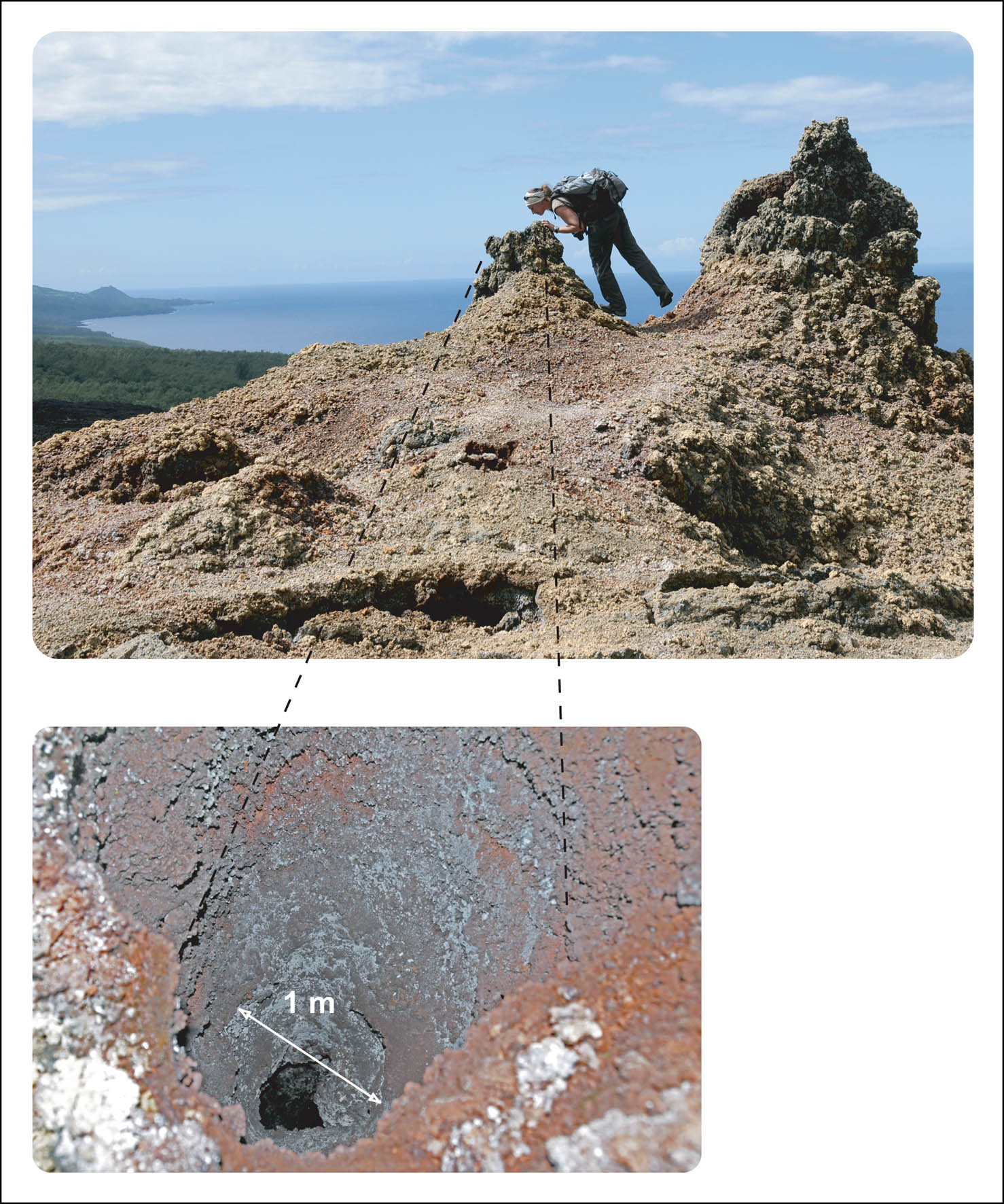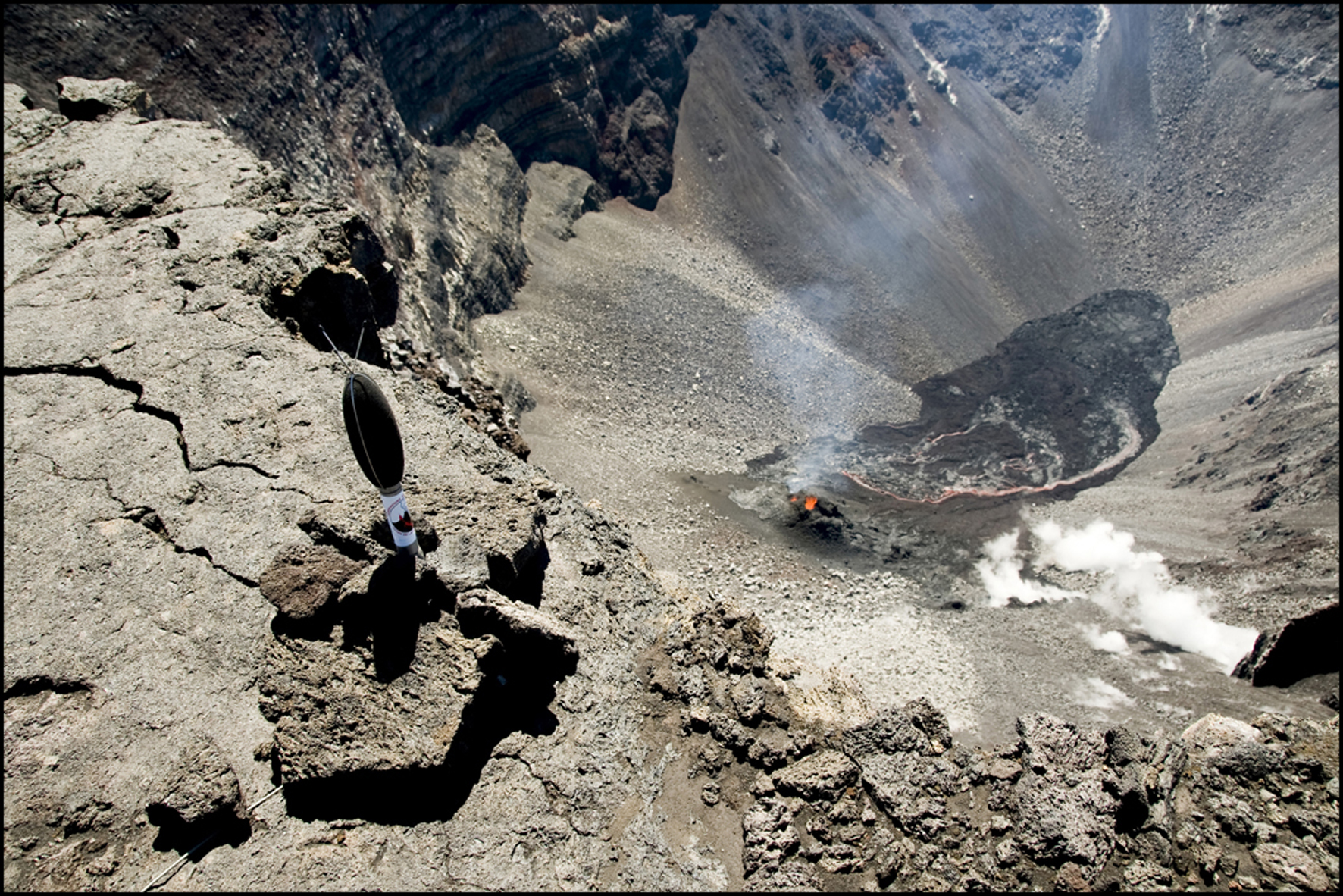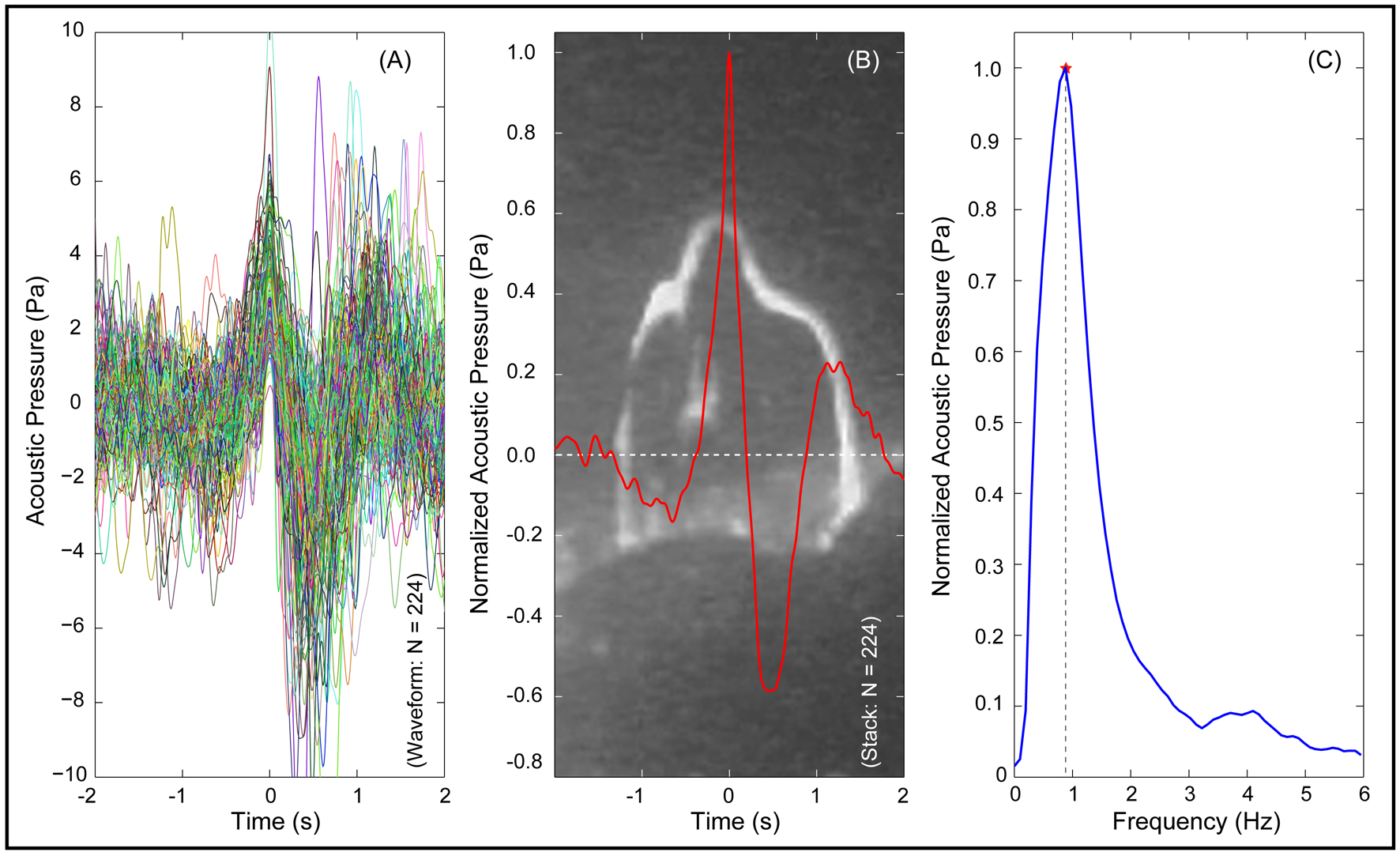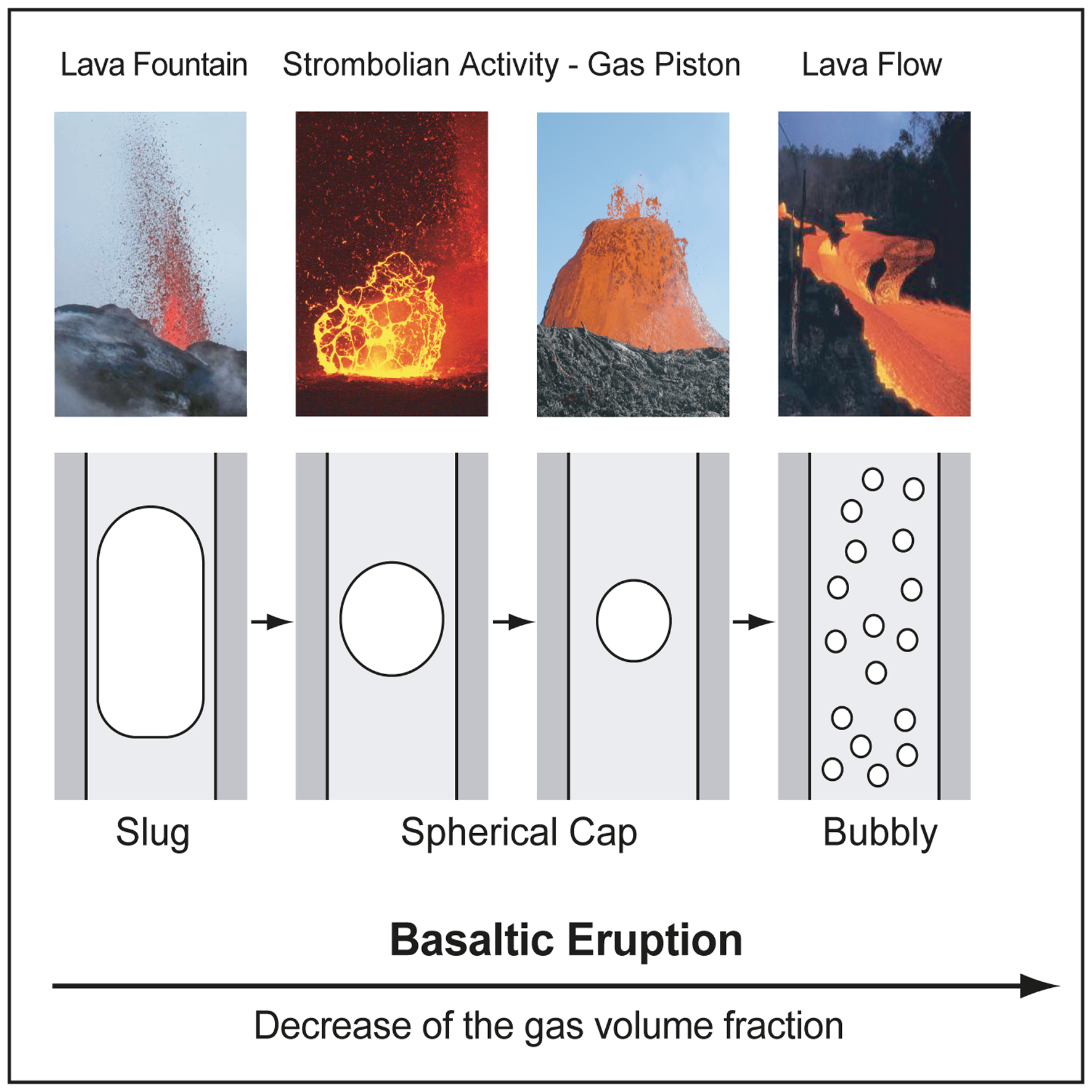
(In the case of Piton de la Fournaise volcano, it's sometimes possible to put the head into the conduit, to observe the course of an eruption.")
Aurélien Dupont – dupont@pusan.ac.kr
Pusan National University
609-735 Busan, South Korea
Popular Version of Paper 1pNSa11
Presented Monday afternoon, May 14, 2012
163rd ASA Meeting, Hong Kong
Introduction
A basaltic eruption is a moderate eruption with a weak viscosity of the magma and gas content. The gas is free to rise through the liquid until it bursts at the surface of the lava column: at this moment, gas bubbles are often seen.
Then the volcanologist is able to approach very closely the phenomenon, which is not usually possible with volcanic eruptions (Fig. 1).
The hot spot volcano of Piton de la Fournaise, located on the Reunion Island, erupts often. It is a perfect field laboratory to test and to adapt new survey techniques, like infrasonic monitoring.
Far away from an eruption, the visitor of Piton de la Fournaise can hear very low frequency noise, but the source of the sound is not well constrained and can be intriguing, especially during bad weather conditions, when it's impossible to see.
However, if the visitor approaches near the eruption (~ 100 m), the acoustic near-field allows the visitor to distinguish clearly several different phenomena like:
. Gas explosion and the fallout of ejecta outside of the crater rim ("FIG_Dupont_Sound-7 / caption: Gas explosion and ejecta fallout")
. Extrusion of a lava flow ("FIG_Dupont_Sound-8 / caption: A bubbly lava flows into a lava tube where gas bubbles of few centimeters are observed to burst")
. Fumaroles noise ("FIG_Dupont_Sound-9 / caption: A fumarole pierces the walls of a pyroclastic cone during an eruption where the magmatic gas in overpressure escapes into the atmosphere.")
. etc.
But, what is the main source of the sound during a basaltic eruption?

(In the case of Piton de la Fournaise volcano, it's sometimes possible to put the head into the conduit, to observe the course of an eruption.")
Instrumentation
An acoustic sensor like a microphone (Fig. 2) can answer this question. It shows that most of the acoustic energy of an eruption is in the infrasonic frequency range. The main source of the sound is linked to the explosion of over-pressurized gas pockets where magmatic gases expand in atmospheric pressure.
The acoustic sensor detects the sound produced from the gas flow. If no volcanic gas escapes anymore from the vents, detections stop and the eruption is over. Infrasound can accurately characterize the beginning and the end of an eruption.

(Infrasound sensor could be a micro-barometer as well as a condenser microphone. The instrument detects the flow of gas. The eruptive dynamics are associated with a blue color gas, escaping from the vent (SO2): while a white color degassing (water vapor), resulting from dehydration of the crust, does not contribute to the eruptive dynamics.")
Gas bubble observation
Two families of impulsive waveforms associated with bubble explosions can be discriminated by the noise produced by an eruption on Piton de la Fournaise volcano. The first one is associated with an important acoustic pressure (~ 7 Pa) and a low frequency waveform (~ 1 Hz). These bubbles, much longer than the conduit width, are cylindrical shape and are characteristics of slug flow (Fig. 3 - B). They are found at beginning of the eruptions, associated with the stronger fluid flow, which is known as the lava fountain regime (Fig. 5 - part 1).
The second category, the most common, is associated with weak acoustic pressure (~ 3 Pa) and a high-frequency waveform (~ 4 Hz). The vertical dimension of these bubbles is similar to their radial dimension. Their shapes are roughly hemispherical and characteristic of spherical cap bubbles (Fig. 4 - B). This gas pocket is found throughout the duration of the eruption and is characteristic of the so-called Strombolian activity (Fig. 5 - part 1 and 2).

(Low frequency waveform signature of the curtain of fire activity (~ 1 Hz). Bubbles are roughly cylindrical with about 2 m and 3 m diameter and vertical dimension between 6 m and 8 m. Their shapes are characteristic of slug flow.)

(High frequency waveform signature (A) of the Strombolian activity (~ 4 Hz). Bubbles are roughly hemispherical with about 2 m and 3 m diameter. The vertical dimension of these bubbles, which appears after the bursting, is similar to their radial dimension (B). Their shapes are characteristic of the spherical cap bubbles. The coda of this event (C)could be interpreted as sloshing waves at the free surface of the magmatic conduit after the explosion.")
Detection and modeling
The detection of the explosions gives precious details on the eruptive dynamic. In particular, the careful study of the waveforms of explosions allows us to understand how the gas is emitted from the vent. It is useful to characterize eruptive regimes (Fig. 6). The waveforms modeling led to an estimation of the volume of the gas pockets (Fig. 5 - D) and, in the case of the most accurate modeling, to estimate the bubbles' overpressure.

(Temporal evolution of the acoustic pressure, power, number and eruptive gas volume calculated per 60 second samples during the course of a basaltic eruption on Piton de la Fournaise volcano. In Part 1, in red, the parameters associated with the first family of explosion of gas pockets - the "slug flow" type - are calculated. While in blue color, the parameters for the "spherical cap" bubble type are calculated. Degassing is at the highest when the eruption started, which is the regime so called "lava fountain". The acoustic data are contaminated by wind noise but its contribution to the gas volume budget is null.")
Conclusion
The tracking of the main source of noise during the earuptions shows that the size of the gas pockets, which are at their highest at the beginning of the eruption - called the Lava Fountain regime - constantly decreases until it disappears with the eruption's end: the gas volume fraction constantly decreases in the volcanic conduit during a basaltic eruption.
The eruptive regime could be characterized by the volume, the number and the overpressure of the gas bubble bursting at the surface of the lava column.
If we compare an eruption as a pneumatic design (where the volcanic gas is initially contained in an over-pressurized magma reservoir and is expanding to the surface at atmospheric pressure), then volcanologists are able to use infra-sounds as a flow meter and a manometer to better survey the volcanic activity.

("FIG_Dupont-6 / caption: During the course of an eruption, the gas volume fraction decreases in the volcanic conduit until there is no longer any gas and the eruption stops. The meticulous observation of gas bubbles during eruptions allows to isolate several eruptive regimes. These regimes are like pieces of puzzle. Gathering all together, it is easy to understand what it is usually called the basaltic eruption.")